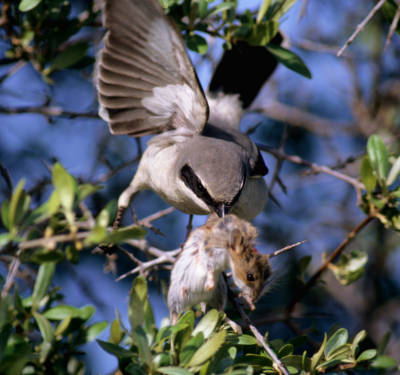Birds preying on lizards in Qatar
Researchers are hoping they can study shrikes hunting lizards in Qatar to boost efforts for conservation of rare species.
Published online 30 June 2015

Shrikes do not have talons for hunting, but they overcome this limitation by using the environment to impale their prey.
© All Canada Photos / Alamy
A collaborative study of an international team of researchers provides the first evidence that shrike birds prey on lizards in Qatar1.
Shrikes are passerine birds belonging to the genus Lanius, which behave similarly to birds of prey. Unlike raptors, however, shrikes do not have the strong talons needed for tearing up flesh. They overcome this by impaling their prey with sharp objects such as barbed wire, cacti, and thorns. This serves to immobilize and kill their prey, and aids feeding and storage of food. It also advertises territory ownership to other shrikes as well as the male’s prowess to potential mates.
There are 29 shrike species worldwide, many of which prey on invertebrates, but some of the larger species, such as L. meridionalis, the only species resident in Qatar, hunt a wide variety of vertebrates, including amphibians, reptiles, other birds and small mammals, including bats.
A team of scientists from Qatar, Spain, Romania and France started in 2011 a preliminary inventory of lizards in Qatar and identified 21 different lizard species.
While performing their field work near Al Jassasiya in north-eastern Qatar, they found a live male Hadhramaut sand lizard (Mesalina adramitana) freshly impaled on a palm tree, approximately one-and-a-half metres above the ground. Although the researchers did not see the event directly, the presence of shrikes in nearby shrubs, together with the method of impalement, strongly suggests that the shrikes preyed on the lizard.
Reports of shrikes preying on amphibians and reptiles come most often from North America and Europe. This is the first time this predatory behaviour has been reported in Qatar, and the authors also believe that theirs is the first report of this lizard species being hunted by shrikes.
The researchers note that others have also found other rare and elusive skink lizards in the same condition, impaled on plants, or found their scattered body parts in kestrel pellets. They therefore suggest that searching for animals hunted by shrikes could be a useful way of keeping an inventory of rare and elusive species, and that this may help them to estimate how shrike predation affects vulnerable lizard communities in Qatar.Reference
- Cogălniceanu, D, et al. Shrike predation on the lizard Mesalina adramitana in Qatar; a review of reported reptile and amphibian prey. QScience Connect 2015,1 (2015). | article
DOI: 10.1038/qsh.2015.66

